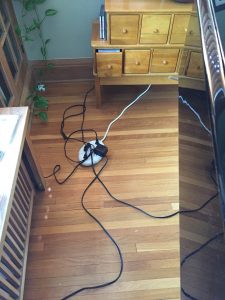Before I get started on this post . . . I have started reading How Doctors Think by Jerome Groopman, which is the selection for our online Healthy Matters book club. Check out the recent post about it here and start reading!
Falls

Zoe needs to clean up her toys
Check out our dog, Zoe.
She is a sweet and happy beast with bad hips and definitely has some issues with staying tidy. This is a small sampling of her extensive toy collection which is strewn throughout our house. She’s a slob.
So why am I showing pictures of my dog?
Just imagine yourself in the middle of the night navigating that minefield of toys and dog beds and sleeping dogs and not tripping. Ugh. I’m going to talk about falls, mostly in the elderly, but really it could be in anybody.
In this post you will find:
- Photo evidence of my “research” in the form of an unplanned walk through my own house.
- A story of a patient for whom a fall was life-changing.
- Risk factors for falls.
- Lots of links to great resources and videos.
- Guidance from experts in fall prevention from the Healthy Matters radio show.
- Two cools things – a checklist for safety in your own home and video clips which demonstrate the effect of vision on falls. Check out both of these later in this post
Why care about falls?
 In the grand scheme of health care topics, falls don’t seem to arouse much excitement in people. Now cancer, heart disease, stroke . . . those are real diseases that get your attention. They just sound dangerous. But falls? What’s the big deal? Falling down while walking down the sidewalk doesn’t seem quite so threatening.
In the grand scheme of health care topics, falls don’t seem to arouse much excitement in people. Now cancer, heart disease, stroke . . . those are real diseases that get your attention. They just sound dangerous. But falls? What’s the big deal? Falling down while walking down the sidewalk doesn’t seem quite so threatening.
But the reality is quite startling. Falls, particularly in older adults, are a really big deal.
The story of Aaron and Patricia
Let me tell you about two recent patients of mine.
(Note that all the identifying details of this story have been changed to protect the privacy of the patients. As always on this blog, I will never use any actual patient information. When I tell stories about patients, please know that these are fictionalized accounts and you will never be able to identify a real person in them. But this story is realistic – happens all the time. This story is based on a composite of several patients I have known.)
Aaron and Patricia are both in their 80s and lead an active life. They like to go to concerts and often get dinner before a show. Aaron used to play golf with his friends but that is slowing down a bit now, though occasionally he gets out for 9 holes. Patricia stays home much of the time as her arthritis causes her lots of knee and hip pain. They live together in the house they purchased some 42 years ago and overall are happy and doing well. The bedroom is upstairs so that is tough for Patricia, with her sore knees and all, but they plan on staying in their home as long as they can. As long as Aaron can do the physical chores around the house, Patricia can manage.
One evening Aaron was out running errands. He drove up to the post office but couldn’t reach the mail chute, so he stepped out of his car, walked around the car to the mail box, and accidentally tripped on the curb. He fell to the ground on his side and felt pain in his right hip area.
Fast forward a few hours.
Aaron is brought to the Emergency Department. He is found to have a broken hip, requires surgery, and then goes to a rehab facility for 3 weeks. He needs a walker after that and can no longer take out the garbage, go up and down stairs at home, and can no longer help out much around the home. Patricia can’t manage given her bad knees, and they need to sell the home and move to an assisted living.
Going to concerts is pretty tough now. They mostly hang out in their apartment and play cards, maybe watch some TV. Patricia’s knees continue to hurt her. Aaron’s mood is down and he isn’t real excited about life anymore. He misses his house, his workshop in the basement. Patricia misses her garden.
Aaron and Patricia’s life would never be the same again. And this admittedly fictionalized story has a relatively good ending. After all, they are still together and still have a good quality of life. But they had to sell their home before they wanted to. Whereas they used to go out to dinner and concerts, now their meals are in a dining hall down the corridor from their apartment. They don’t get out as much since Aaron can’t drive anymore. He’s saddened, and more than a little embarrassed, by the whole thing. All because of a silly trip on a curb.
It could have been worse
And it could have been much worse. The scientific data on hip fractures and falls in the elderly is clear about a few things:
- A quarter of a million people over age 65 will be hospitalized for hip fracture every year.
- Women fracture hips more often than men.
- The long-term outcomes after hip fracture often include loss of independence, ability to walk or carry on usual activities.
- Some people will not survive a hip fracture. Studies show that anywhere from 14-58% of people with hip fracture will not be alive in one year.
I share these sobering statistics not to scare people; rather I think it important to know the facts so that folks can take some steps to help reduce their own risk for falls.
There are lots of sites with reliable and helpful information about falls that I hadn’t seen before but which I found informative. For starters, here is a site by the Centers for Disease Control (CDC).
Cords, dogs, ice. Life is full of hazards
If you are interested, here is a good introductory video about falls (about 19 minutes long). I had to chuckle during the scene of a bunch of electric cords (looks just like my house, as the photos later in this post will prove) and during the snowstorm scene (basically an average Tuesday on a Minnesota January day).
Preventing falls

Julie Philbrook, RN, MAN, MAL
On the Healthy Matters radio broadcast this week, we talked about ways to reduce the risk of having a fall. And the good news is (after that rather bleak previous section a couple paragraphs above!) is that there are plenty of things people can do to make a fall less likely. To help me with this, I invited HCMC Trauma Prevention Coordinator Julie Philbrook to join me in the studio. That’s her in the picture at left. No, I don’t know what all those initials after her name mean, either. Let’s just say she’s really smart!
Listen to the podcast of the show with Julie by clicking on the logo at right.
Julie told us of a few factors that make people more likely to fall. What strikes me about all this is that it is actually quite incredible that humans are able to stand upright at all! Good grief it takes nerves in our feet, a central nervous system in our brains, balance functions in our ear, a complex visual system with functioning eyes, and lots more. There are so many body functions that make it possible for our amazing bodies to do what we do every day. When just one of those body functions isn’t working quite right then problems happen – like falls.
Here is a list of risk factors for falls that I got from the CDC website.
You are more likely to fall if you have one or more or these conditions
- Lower body weakness
- Vitamin D deficiency (that is, not enough vitamin D in your system)
- Difficulties with walking and balance
- Use of medicines, such as tranquilizers, sedatives, or antidepressants. Even some over-the-counter medicines can affect balance and how steady you are on your feet.
- Vision problems
- Foot pain or poor footwear
- Home hazards or dangers such as
- broken or uneven steps,
- throw rugs or clutter that can be tripped over, and
- no handrails along stairs or in the bathroom.
Let’s look at a few of these in more detail.
Home safety: a confession.
Most of us think our homes are the safest place, right? But it is true that most falls occur at home. Things you may not even notice can increase your risk for falls.
Before you read on, I suggest going over this Check for Safety exercise available from the CDC. Go through the checklist and see if your home could use a safety upgrade. I looked at my home and, holy cow, my own place needs help. It is well worth your time to do the checklist.
Now the confession. Look at my own home:
Our dog, Zoe, could do a better job of picking up her toys, don’t you think? (See picture at top of this post).
And check out the scene in the corner of the room at my house:

A ball o’ cords, just waiting to be tripped over.
And here is the rug in our front entryway at home. Lots of problems here:
- Rug is loose and sliding around
- Sneakers are right in the path of walking
- Rug overlaps the rug next to it, creating a bump to trip over
- And perhaps most important, it’s an ugly rug .
OK, I promise, I’ll work on my own home. How about you?
Vision and falls
 Now let’s look at vision. Why would eye and visual problems matter for falling?
Now let’s look at vision. Why would eye and visual problems matter for falling?
Your vision plays an important role in keeping you upright. But rather than me trying to explain why visual problems are well, a problem, I’d like you to check out this article from the New York Times. I especially encourage you to look at the three video graphics in the article. It is best to read the article and view the videos there as they include context on what you are seeing.
But if you prefer, click on the links in the following paragraphs if you don’t want to read the whole article. As each ~10 second long video clip progresses, your “vision” gets worse. All videos are from the New York Times (thanks, guys).
The first video demonstrates how stairs look to people with normal vision and then how they look with visual problems. The left side of the screen is shown as many of our homes look, and the right side of the screen is with tape on the stairs to show a simple intervention that can reduce falls.
The second video shows how a shower stall appears to a person with normal vision and to a person with impaired vision. Again, the right side shows a shower stall with darkened edges to demonstrate a simple intervention that you can do.
Finally, a third video shows how a toilet seat may look to people with visual problems. Notice how the black seat is better!
These are powerful images. You can imagine why a person with cataract, glaucoma, macular degeneration, detached retina, diabetic retinopathy, or any other visual problem could be at increased risk of falling. And many of these are treatable vision problems!
Not looking old, I get it.
 On the radio broadcast Julie and I also talked about the natural tendency for people to resist the reality that they are at a higher fall risk. Using a cane may make you feel old and less vigorous. Going to the side of the big staircase to grab the handrail may seem like an admission that you are not as strong as you once were.
On the radio broadcast Julie and I also talked about the natural tendency for people to resist the reality that they are at a higher fall risk. Using a cane may make you feel old and less vigorous. Going to the side of the big staircase to grab the handrail may seem like an admission that you are not as strong as you once were.
Yeah, that’s a real thing.
I don’t want to minimize the need that many people have to remain as strong and vigorous and youthful-in-appearance as they possibly can. That’s OK.
But maintaining independence may well depend on avoiding a fall. You can actually be more vigorous and more active and more independent if you take some simple steps toward reducing risk of falling. Just my opinion. I’ll probably be just as stubborn when I’m a bit older as well!
Lastly, here are a few more online resources that I think are reliable. Check ’em out if you want!
Online resources
Hennepin County Medical Center Trauma Prevention Services. General information about a range of trauma issues.
Metropolitan Area Agency on Aging. Offers links to classes (in Minnesota) for on maintaining balance and Tai Ji Quan (a practice that we talked about on the radio broadcast).
Leave me your thoughts in the “Leave a Reply” section below. And thanks for checking in with me at Healthy Matters!
-David

